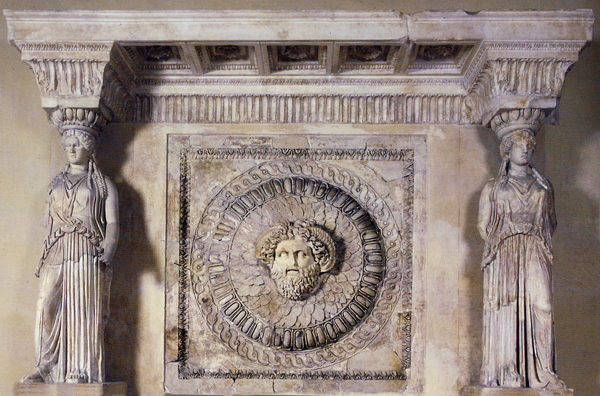

"he [Augustus] forced the chiefs of certain barbarians to take oath in the temple of Mars the Avenger that they would faithfully keep the peace for which they asked; in some cases, indeed, he tried exacting a new kind of hostages, namely women, realizing that the barbarians disregarded pledges secured by males."
Suetonius, Augustus (XXI.2)
The replication of the attic above is in the House of the Knights of Rhodes and constructed in the 1940s. The caryatids, which are copied in reduced scale from the figures of the Erechtheion on the Athenian Acropolis, alternate with roundels depicting Jupiter Ammon, the ram-horned god proclaimed to be the father of Alexander the Great, whose portraits also were displayed in the forum. It is an association between an Augustan Rome and a Periclean Athens that was quite deliberate. Here, the capital imitates a wicker basket (canistrum), which gives another name to these caryatids: canephoroi or "basket-bearers." Pieced together from fragments, most of which have been recomposed in this single composite pastiche, one sees how the decoration may have looked, with the caryatids standing forward of the wall and supporting an architrave with a line of deep coffers beneath it.
But it is not known how much of the porticoes was decorated in this way, whether the head of Jupiter was repeated or the heads of barbarians or gods were used instead, or even whether the series continued the length of the colonnade. The newer reconstruction below shows the head of a Celtic warrior, as can be discerned by the fragment of a torc around his neck. The lion head dripstone is displayed as well. Unlike the caryatids of the Erechtheion, these copies are more full bodied and do not stand free of the wall; rather, their backs are slightly compressed.
This use of a portrait bust framed within a shield or circular medallion (roundel) is termed imago clipeata.
The recomposition (top) is in the Casa dei Cavalieri di Rodi (Rome) and virtually inaccessible except by appointment. More approachable is the reconstruction in the Museo dei Fori Imperiali (Museum of the Imperial Forums).
Reference: Roman Sculpture (1992) by Diana E. E. Kleiner.
![]()